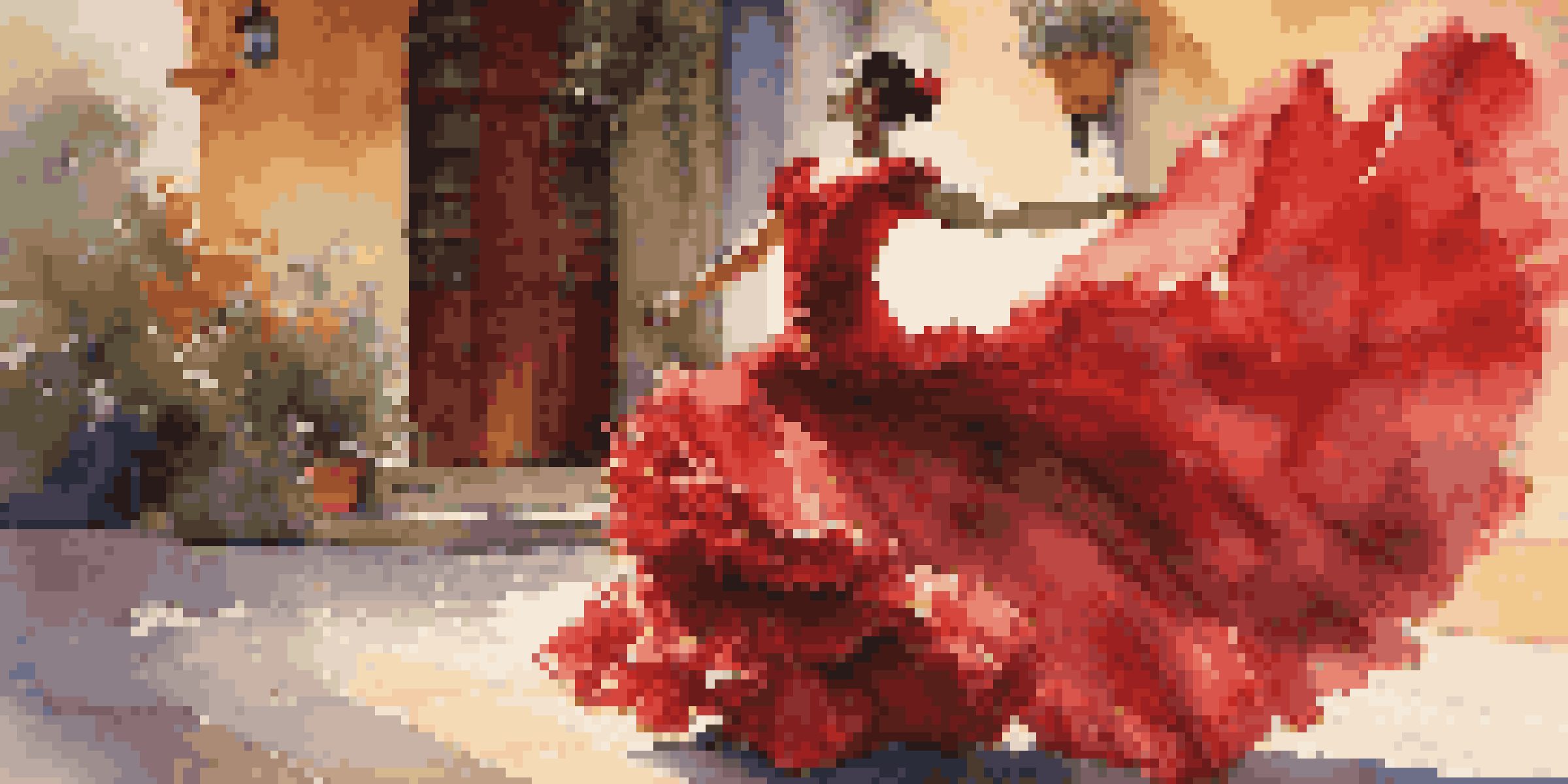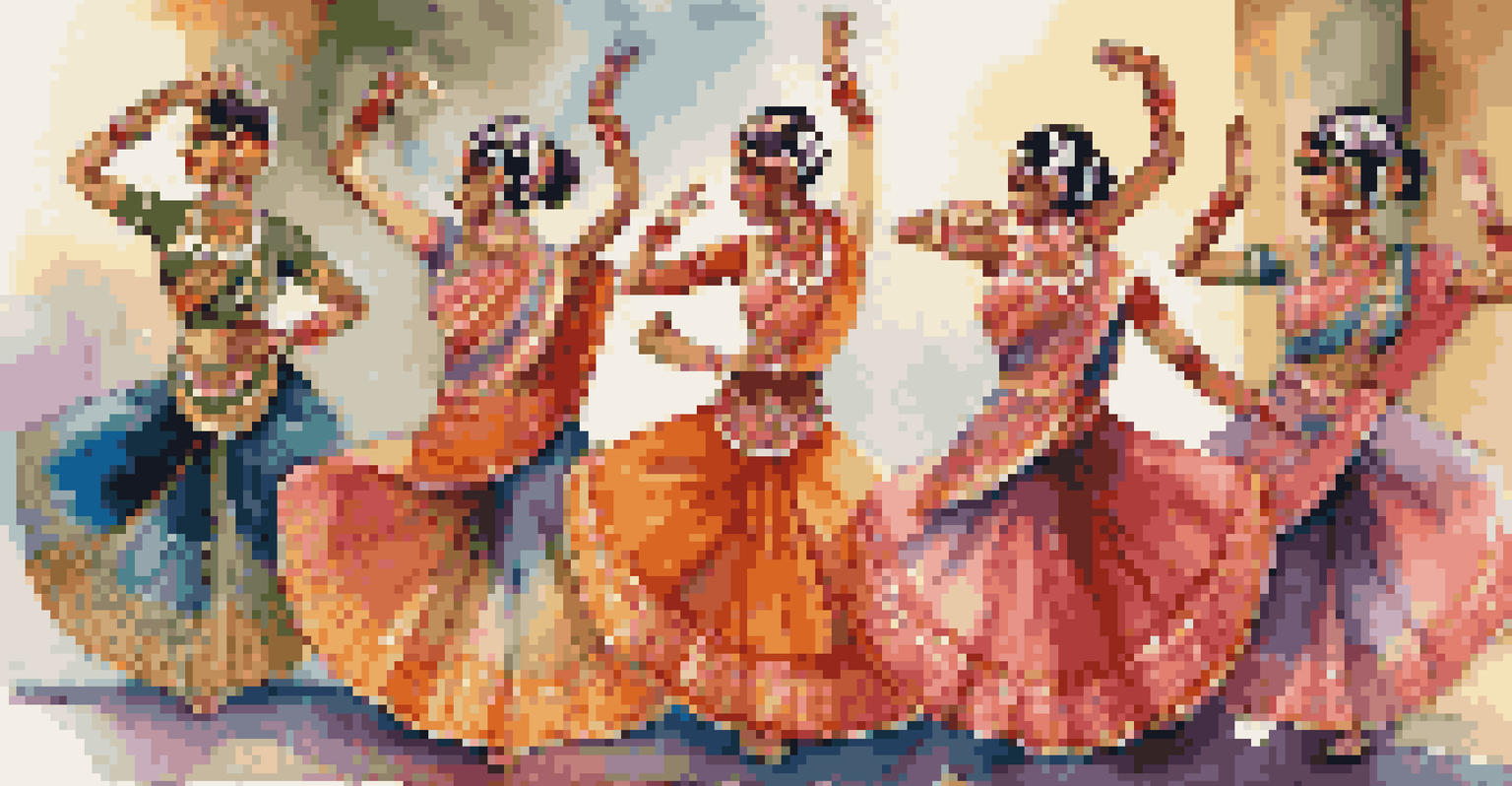Regional Variations in Dance Attire: A Comparative Study

Understanding the Importance of Dance Attire
Dance attire is not just about aesthetics; it plays a crucial role in performance. Each region has its own traditional costumes that reflect cultural values, history, and identity. For dancers, the right attire can enhance movement and express the essence of their art form. Understanding the significance of these outfits is key to appreciating the dance itself.
Dance is the hidden language of the soul.
For instance, in ballet, the tutu symbolizes grace and elegance, allowing for fluid movements that captivate audiences. In contrast, traditional Indian dance forms like Bharatanatyam utilize intricate costumes adorned with jewelry, which tells a story as much as the dance does. Thus, attire becomes a vital element of the storytelling process in various dance genres.
Moreover, dance attire often evolves with cultural changes, showcasing how traditions adapt over time. This dynamic nature of dancewear highlights the ongoing dialogue between culture and performance, making it a fascinating subject of study.
Regional Variations: A Closer Look at Styles
Different regions around the world showcase unique dance styles, each with distinctive attire. For example, the flamenco dancers from Spain wear vibrant dresses adorned with ruffles, embodying passion and intensity. Meanwhile, the indigenous Maori culture of New Zealand features traditional garments made from natural fibers, emphasizing a deep connection to nature and heritage.

These regional variations not only reflect local aesthetics but also the social and historical contexts of the communities. In Africa, for example, dance attire often incorporates colorful fabrics and beadwork, which signify tribal identity and cultural pride. This rich diversity in attire provides a visual representation of each region's narrative and traditions.
Attire Enhances Dance Performance
The right dance attire not only complements the aesthetics of a performance but also significantly influences a dancer's movement and confidence.
As we explore these regional differences, we can appreciate how dance attire serves as a canvas for cultural expression. The choices in fabric, color, and design are often steeped in symbolism, making each outfit a story waiting to be told.
The Role of Fabric and Material in Dance Attire
The choice of fabric and material in dance attire plays a significant role in both comfort and performance. Lightweight fabrics like chiffon or lycra are often favored in contemporary dance for their flexibility and breathability. In contrast, traditional outfits may utilize heavier materials that lend grandeur and structure to performances.
The dance is a poem of which each movement is a word.
For example, the silk used in Chinese classical dance creates a beautiful flow and visual appeal as dancers move, enhancing the overall aesthetic. Similarly, the use of leather in Irish dance shoes provides the necessary support and durability for intricate footwork. Each material is chosen not just for its look but for how it influences the dancer's movement.
Additionally, the durability of materials can affect how traditions are passed down through generations. While some dance forms maintain their original attire, others have adapted modern materials to enhance comfort and functionality without losing their cultural essence.
Cultural Significance of Traditional Dance Attire
Traditional dance attire often carries significant cultural meaning, serving as a representation of a community's heritage. For many cultures, these outfits are passed down through generations, symbolizing continuity and connection to ancestors. For instance, the intricate beadwork in Native American dance costumes often tells stories of the tribe's history and beliefs.
In many African cultures, specific colors and patterns in attire can indicate social status, role in the community, or even marital status. This layered meaning adds depth to the visual spectacle of dance, inviting audiences to engage with the performance on a more profound level. The attire becomes a bridge between the dancer and the cultural narrative being expressed.
Cultural Heritage in Dance Wear
Traditional dance attire is deeply rooted in cultural significance, representing community heritage and storytelling through its design and materials.
Understanding these cultural significances allows audiences to appreciate the performances beyond mere entertainment. It fosters a greater respect for the traditions and stories woven into the fabric of each dance form, reinforcing the idea that dance is a powerful medium for cultural expression.
Modern Influences on Dance Attire
In today's globalized world, modern influences are reshaping traditional dance attire. Dancers often blend contemporary styles with traditional elements, resulting in innovative and unique looks. This fusion not only revitalizes traditional forms but also makes them more accessible to younger generations who might not connect with the original styles.
For instance, hip-hop dancers may incorporate streetwear elements into their performances, creating a fresh take on dance attire while still honoring cultural roots. This blending of styles can lead to exciting collaborations and performances that celebrate both tradition and modernity.
However, this evolution raises questions about cultural appropriation versus appreciation. It's essential for dancers and choreographers to approach these influences with respect, ensuring that they honor the origins of the attire they incorporate into their work.
The Impact of Dance Attire on Performance
The attire worn by dancers can significantly impact their performance, influencing everything from movement to confidence. Well-fitted costumes allow for unhindered movement, enabling dancers to execute complex choreography seamlessly. On the other hand, ill-fitting or uncomfortable attire can distract dancers and hinder their ability to perform at their best.
Moreover, the psychological aspect of wearing specific attire can boost a dancer's confidence. Just like athletes don uniforms that represent their team, dancers often feel empowered in their costumes, which can enhance their stage presence. This connection between attire and performance highlights the multifaceted role of dancewear in the world of dance.
Modern Trends Shape Dance Attire
Contemporary influences are transforming traditional dance attire, creating innovative blends that resonate with younger generations while maintaining cultural respect.
Ultimately, the right attire contributes to the overall visual spectacle of a performance, enhancing the storytelling aspect of dance. It creates an immersive experience for audiences, drawing them into the narrative being portrayed.
Preserving Traditional Dance Attire in Modern Times
As dance continues to evolve, preserving traditional dance attire poses a unique challenge. Many communities strive to maintain their cultural heritage while adapting to contemporary influences. Organizations and cultural institutions play a vital role in documenting and promoting traditional attire, ensuring it remains an integral part of dance education.
Workshops and festivals dedicated to traditional dance provide platforms for sharing knowledge about costume creation and significance. By engaging younger generations in these practices, communities can foster a sense of pride in their heritage and encourage the continuation of traditional attire.

Moreover, as global interest in diverse cultures grows, traditional dance attire is gaining recognition on international stages. This visibility not only helps preserve these outfits but also educates wider audiences about the rich tapestry of global dance traditions.